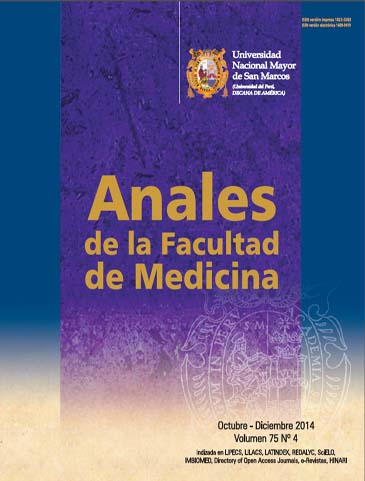Superior third facial fractures at Dos de Mayo National Hospital Head, Neck and Maxillo-Facial Surgery Service, 1999 - 2009
DOI:
https://doi.org/10.15381/anales.v75i4.10845Keywords:
Facial superior third, fronto-orbital region, middle frontal region, fronto-parietal regionAbstract
Introduction: Superior third facial fractures represent an important but rare pathology in the specialty of head, neck and maxillofacial surgery, and result from severe trauma. Objectives: To determine the presentation of superior third facial fractures by age, sex, causal agent and classification. Design: Observational descriptive study. Setting: Head, Neck and Maxillofacial Surgery Service, Dos de Mayo National Hospital, Lima, Peru. Participants: Patients with superior third facial fracture. Methods: Medical records data between June 1999 and May 2009 were captured. Main outcome measures: Age, sex, causing agent and classification. Results: Forty nine patients were included, Ninety pe cent were male, about two thirds (67.5%) were between 21 and 40 years old. More than half of the lesions (55%) resulted from traffic accidents and 23% from robberies; more than 40% had superior third fractures only and 59% were accompanied by midface fractures. Conclusions: Superior third facial fractures are important in the facial region. Clinical diagnosis depends on the affected structure. Treatment should be timely to prevent sequelae and complications. Traffic injuries and robberies are increasingly important causes. This study would contribute to developing treatment protocols in emergency services.Downloads
Published
2014-12-31
Issue
Section
Artículo Original
License
Copyright (c) 2014 Francisco Avello Canisto, José Saavedra Leveau, Ladislao Pasache Juárez, Roberto Iwaki Chávez1, José Núñez Castañeda, Marco Robles Hermenegildo

This work is licensed under a Creative Commons Attribution-NonCommercial-ShareAlike 4.0 International License.
Those authors who have publications with this magazine accept the following terms:
- Authors will retain their copyrights and guarantee the journal the right of first publication of their work, which will be simultaneously subject to Creative Commons Attribution License that allows third parties to share the work as long as its author and its first publication this magazine are indicated.
- Authors may adopt other non-exclusive licensing agreements for the distribution of the version of the published work (eg, deposit it in an institutional electronic file or publish it in a monographic volume) provided that the initial publication in this magazine is indicated.
- Authors are allowed and recommended to disseminate their work over the Internet (eg: in institutional telematic archives or on their website) before and during the submission process, which It can produce interesting exchanges and increase quotes from the published work. (See El efecto del acceso abierto ).
How to Cite
1.
Avello Canisto F, Saavedra Leveau J, Pasache Juárez L, Iwaki Chávez1 R, Núñez Castañeda J, Robles Hermenegildo M. Superior third facial fractures at Dos de Mayo National Hospital Head, Neck and Maxillo-Facial Surgery Service, 1999 - 2009. An Fac med [Internet]. 2014 Dec. 31 [cited 2024 Jul. 17];75(4):319-22. Available from: https://revistasinvestigacion.unmsm.edu.pe/index.php/anales/article/view/10845















